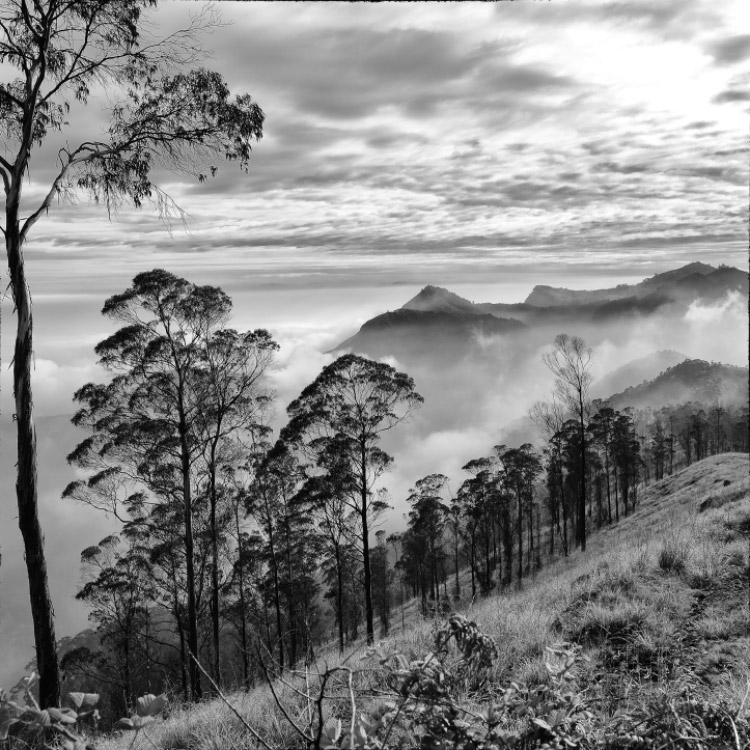Grasslands in Twilight, Shola in Ascendance.
The Palani Hills of Tamil Nadu are in the midst of significant ecological change. It’s not the kind of process that is easily observed and most people, including those managing forest resources, have been taken by surprise by just how fast the montane (high altitude) landscape of the hills has changed. These are the conclusions of regular observation and photo documentation by the author as well as, a peer- reviewed scientific study using satellite imagery coupled with field observations.
The grasslands mapping project that took shape at the plantations conference in Kodaikanal in December 2014 produced a report that was published earlier this year. This is important work and represents the combined efforts of several disparate individuals, organizations and funding agencies. The preliminary visual assessment of Landsat imagery by the author showed that satellite data held spatial evidence of dramatic land cover change in the Western Ghats and Palani Hills but that it needed to be quantified. Robin Vijayan of ISER Tirupati put into motion a study in 2016 with key field work and spatial analysis being done by M. Arasumani and Danesh Khan. Further academic guidance was provided by Arundhati Das, Milind Bunyan and several others. Bob Stewart & Tanya Balcar, of the Vattakanal Conservation Trust, provided key insights on shola regeneration in plantations-the topic that originally brought everyone together. INTACH and ISER Tirupati helped provide funding of the field work. The Tamil Nadu Forest Department was an important stakeholder and helped provide permissions for the field work. Prasen Yadav joined the project to document the work and produce a video of the findings. The study was peer reviewed and published in January 2018. It is publicly available on PLOS One, including access to all the tables of data and charts (see link below).
An alarming conclusion of the study is the great extent to which the montane grasslands have been taken over by non-native trees and weeds. Those of us who have been walking in the hills have had a sense of this but the satellite images providing damning proof. It is also clear that the plantations have spread far beyond the original boundaries that they were originally designed to be in. Most of the southern escarpment has a fire line etched into its grasslands and now plantations species are spreading beyond this boundary and down the steep slopes of montane grasslands. This leads to clear conclusion that, where possible, efforts need to be made to preserve these last remaining vestiges of montane grasslands. The challenge is that, in spite of the surprising resilience of shola tree species, the last montane grasslands are being steadily consumed by plantation (and some shola) species.
Our study concludes:
- Identify and conserve core grasslands: Core grassland areas consist of a few to many hectares of grassland encompassing hillocks, streams, marshes and rock outcrops. These areas, even when nestled in a plantation matrix, should be protected and form the core around which grassland restoration efforts should focus.
- Check invasion in sparsely invaded grasslands: These areas are often characterized by young plantations located in grasslands where grass cover is still extensive. Here, we recommend physical removal of invasive species. Forest departments often have access to significant funding through the Compensatory Afforestation (Bill passed in 2016) funds and these could be utilized for these activities. Such funds could be used for the restoration of marshes, existing grasslands and to manage the invasive plantations.
- Review indiscriminate removal of mature plantations: Mature plantations often have native shola forest regenerating under them and lack native grass cover. Grassland restoration here is likely to be very resource-intensive. Conservation efforts should focus on sparsely invaded and pristine grasslands. In mature plantations, we recommend conducting experimental or controlled studies (like at Vattavada, Munnar, Kerala), perhaps also examining the role of fire, and monitoring soil and moisture conditions in these areas. Moreover, removal of mature plantations could stimulate regeneration of plantation species from saturated soil seed banks. Monitoring of these areas is important to assess the effectiveness of plantation removal.
- Contain agriculture: Our field surveys indicate that paddy cultivation has been discontinued in some marshes. Given the critical role of these marshes in regulating local hydrology, efforts should be made to contain agriculture to the current extent and restore these marshes using a community-led conservation effort.
To get a visual sense of these findings visit Dakshina Chitra (Chennai) where the author’s The Hills of Murugan exhibition of fine art prints and annotated maps highlights the issues mentioned above.
REFERENCES:
1. Ahrestani, Farshid. “To Chop, or Not to Chop? The Issue of Exotic Invasive Trees in the Western Ghats.” Conservation India. 17 April 2018.
2. Arsumani, M. et al. “Not seeing the grass for the trees: Timber plantations and agriculture shrink tropical montane grassland by two-thirds over four decades in the Palani Hills, a Western Ghats Sky Island.” PLOS One. January 2018.
3. Lenin, Janaki “You’d Think Cutting Kodai Plantations Will Save Its Grasslands. It Won’t.” The Wire. 19 September 2017.
4. Lockwood, Ian. “Mapping Montane Grasslands in the Palani Hills.” Ian Lockwood Blog. August 2016.
5. “Land Cover Changes in the Palani Hills: A Preliminary Visual Assessment.” Ian Lockwood Blog. 4 April 2014.
6. Montanari, Shaena (& Prasenjeet Yadav). “Breathtaking Sky Islands Showcase Evolution in Action.” National Geographic. 11 August 2017.
7. Pendharkar, Vrushal. “Palani Hills: Where have the grasslands gone?” Mongabay. 20 February 2018.
8. Rao, Mohan. “Missing the grass for the trees in Western Ghats.” The Hindu. 17 January 2018.
9. Yadav, Prasenjeet. “Save our Shola Grasslands.” YouTube. Web-Video. 16 September 2017.


 CI is a non-profit, non-commercial portal that aims to facilitate wildlife and nature conservation by providing reliable information and the tools needed to campaign effectively.
CI is a non-profit, non-commercial portal that aims to facilitate wildlife and nature conservation by providing reliable information and the tools needed to campaign effectively.